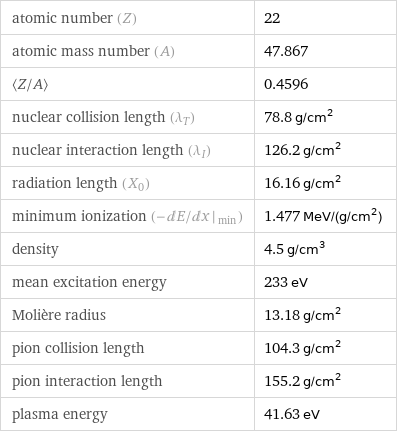Input interpretation

kinetic energy of particle | incident particle | e^- (electron) radiation absorber | titanium thickness | 20 cm
Result

3.7 GeV (gigaelectronvolts)
Comparison as energy for 3.7 GeV

≈ ( 0.04 ≈ 1/25 ) × mass-energy equivalent of a Z boson ( ≈ 1.5×10^-8 J )

≈ ( 0.046 ≈ 1/22 ) × mass-energy equivalent of a W boson ( ≈ 1.3×10^-8 J )

≈ ( 0.075 ≈ 1/13 ) × initial per beam operating energy of the CERN Large Electron Positron Collider in 1983 ( ≈ 8×10^-9 J )
Absorber material properties

atomic number (Z) | 22 atomic mass number (A) | 47.867 〈Z/A〉 | 0.4596 nuclear collision length (λ_T) | 78.8 g/cm^2 nuclear interaction length (λ_I) | 126.2 g/cm^2 radiation length (X_0) | 16.16 g/cm^2 minimum ionization (- dE/ dx |_ min) | 1.477 MeV/(g/cm^2) density | 4.5 g/cm^3 mean excitation energy | 233 eV Molière radius | 13.18 g/cm^2 pion collision length | 104.3 g/cm^2 pion interaction length | 155.2 g/cm^2 plasma energy | 41.63 eV